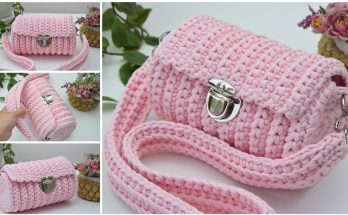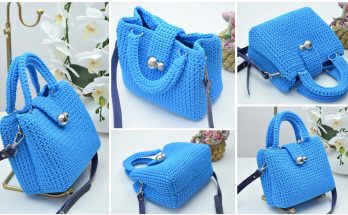
Welcome to a comprehensive guide for crocheting the beautiful and sturdy “Alpine Rib” Shoulder Bag! Inspired by the elegant texture and clean lines demonstrated by SANG DEWI CRAFT, this pattern uses an alternating Front Post and Back Post Double Crochet (FPDC/BPDC) technique to create a beautiful, tight ribbing reminiscent of woven basketry. This technique ensures a structured, self-supporting body.
This is a detailed pattern for an intermediate-level project, resulting in a bag approximately 22 cm wide by 15 cm high. It features a firm rectangular base, a two-tone ribbed body, integrated side folds, and a secure top border with D-ring attachments for the strap.
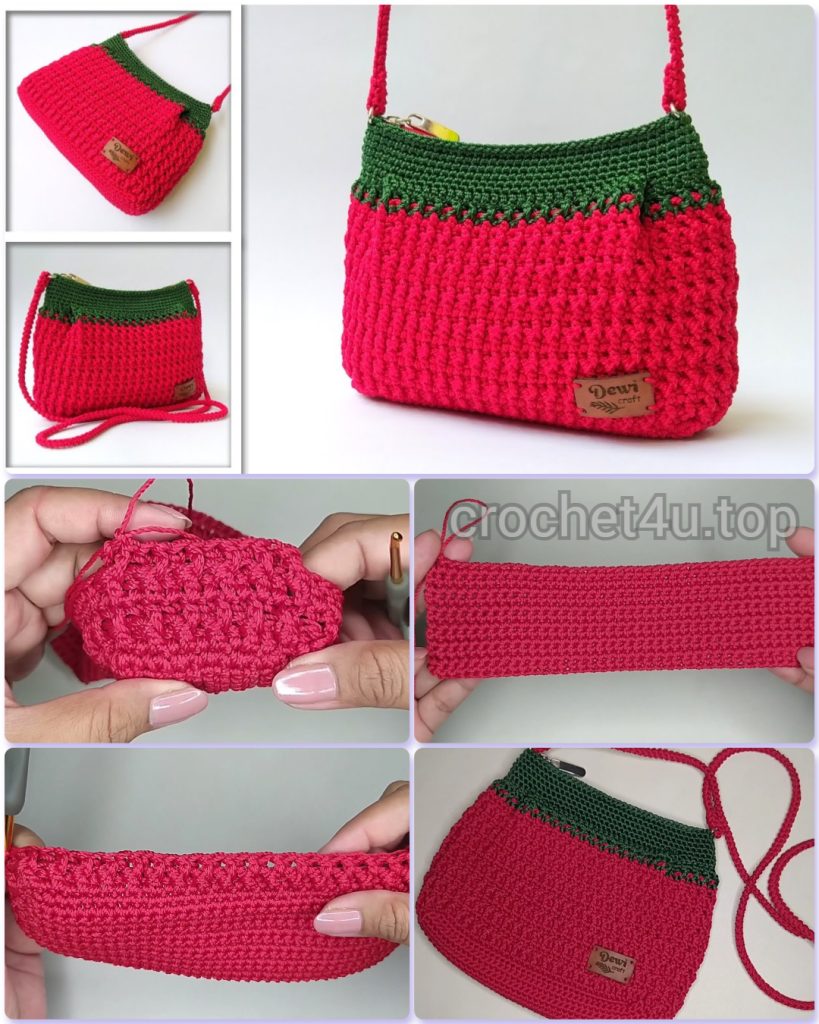
🧶 Materials & Key Tools
The structure of this bag relies on a stiff, non-stretchy cord yarn to maintain its shape.
| Icon | Item | Details |
| Hook | Crochet Hook | 4.0 mm (or size needed to achieve very firm tension). |
| Yarn | Main Color (MC) | Approximately 120g of sturdy cord yarn (Nylon or Polyester cord) for the base and body. |
| Yarn | Contrast Color (CC) | Approximately 40g of the same yarn type for the top accent. |
| Hardware | D-Rings (2) | 1.5 cm size, for secure strap attachment. |
| Hardware | Shoulder Strap | A separate crocheted cord, leather strap, or chain (approx. 100 cm long) with snap hooks. |
| Notions | Markers & Needle | Stitch Markers (especially for the base and side folds), Scissors, and a Yarn Needle. |
| Size | Finished Bag | Approx. 22 cm (Length) x 15 cm (Height) x 6 cm (Depth). |
| Weight | Finished Weight | Approx. 160 grams. |
📝 Abbreviations & Special Stitches (U.S. Terms)
Familiarize yourself with these standard U.S. crochet terms. Note that all body rounds are turned to eliminate a noticeable seam line.
| Abbreviation | U.S. Terminology | Description |
| ch | Chain | |
| sl st | Slip Stitch | |
| sc | Single Crochet | |
| dc | Double Crochet | |
| st(s) | Stitch(es) | |
| rep | Repeat | |
| FPDC | Front Post Double Crochet | DC worked around the post of the stitch below, from the front. |
| BPDC | Back Post Double Crochet | DC worked around the post of the stitch below, from the back. |
| MC | Main Color | |
| CC | Contrast Color |
📐 Part 1: The Rigid Foundation Base
We start with a flat, rigid base worked in rows of Single Crochet, then edged in the round to set up the body’s stitch count.

Initial Chain (MC):
Make a slip knot and ch 40. Chain 1 more for turning.
Rows 1 – 12 (Base Core):
- Sc in the 2nd ch from the hook, and sc in each ch across. (40 sc).
- Ch 1 (does not count as st), turn. Sc in the first st and in each st across. (40 sc).
- Repeat Row 2 until you have completed a total of 12 rows.
Edging (SC in the Round):
After Row 12, do not turn. We work SC around the entire perimeter. The final stitch count must be an even number (a multiple of 2) for the rib pattern.
- Corners: Work 2 sc into the corner stitches (total 4 corners).
- Long Sides (Row Ends): Sc evenly down the side edge, placing 1 sc per row end. (12 sc total per side).
- Top/Bottom Edges: Sc across the 40 SC of the top and bottom rows.
- Count & Join: Count your total stitches (e.g., approximately 104 sts). Ensure your final count is even. Sl st to the first sc to join.
🌟 Part 2: The Alpine Rib Body Motif (MC)
The body uses a four-round sequence to create the beautiful, alternating texture and structure.
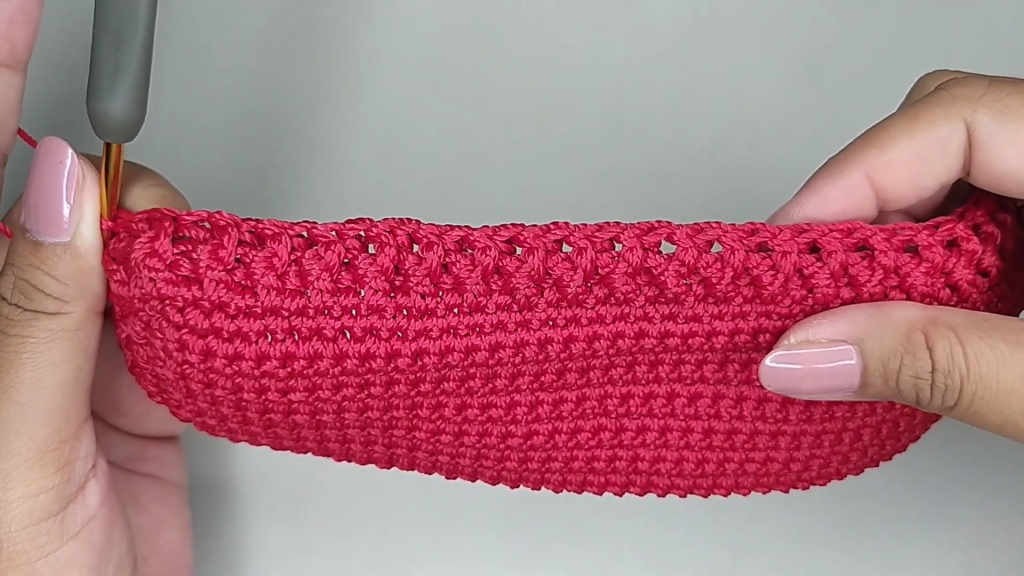
Round 1 (DC Setup):
- Ch 3 (counts as 1 dc), turn the work. Dc in each st around.
- Sl st to the top of the starting ch-3 to join.
Round 2 (FPDC/BPDC Rib):
- Ch 1 (does not count as st), turn.
- *FPDC around the post of the first st. BPDC around the post of the next st***.
- Repeat from * to * around.
- Sl st to the top of the first FPDC to join.
Round 3 (DC Setup):
- Ch 3 (counts as 1 dc), turn. Dc in each st around.
- Sl st to the top of the starting ch-3 to join.
Round 4 (Reversed FPDC/BPDC Rib):
- Ch 1 (does not count as st), turn.
- *FPDC around the post of the first st (which was a BPDC in R2). BPDC around the post of the next st (which was a FPDC in R2)***.
- Repeat from * to * around.
- Sl st to the top of the first FPDC to join.
Body Motif Repetition (MC):
Repeat Rounds 1, 2, 3, and 4 sequence until you have completed a total of 15 rounds of the motif. (e.g., 3 full 4-round sets, plus R1, R2, R3).
Color Accent Rib (CC):
Join CC (Contrast Color).
- Ch 1 (does not count as st), turn.
- Repeat Rounds 2 and 4 sequence using CC for a total of 2 rounds.
- Fasten off CC.

⛓️ Part 3: Side Folding & Final Border
This unique feature gives the bag its distinctive boxy shape and sets up the top closure.
Round 1 (SC Setup – MC):
Join MC to any stitch.
- Ch 1, turn. Sc in each st around. Sl st to join.
Side Folding Placement:
- Flatten the bag. Use stitch markers to identify the four key corners where the base meets the body.
- Measure 6 cm inward from the corner markers on the long side (front and back). Place new markers at these 6 cm points. You will now have 8 markers (4 corners, 4 side-fold marks).
- Count the Stitches: Count the stitches between the side-fold markers. This number should be approximately 9 stitches wide (a multiple of 3).
Side Folding SC:
- Work SC across the front panel until you reach the first side-fold marker.
- Side Fold Technique: You will now fold the corner stitches inward. Locate the following stitches at the corner (as indicated in the video):
- Stitch 1: Corner stitch
- Stitch 2: Stitch next to the corner stitch on the long side
- Stitch 3: Stitch next to the corner stitch on the short side
- SC3TOG: Insert hook into Stitch 1, then into Stitch 2, then into Stitch 3, and complete a SC (SC3TOG over the corner fold). The video shows a less conventional folding/closing method, but SC3TOG works best to reduce the corner width.
- Continue SC across the narrow end (the new side) until the next side-fold marker.
- Repeat the SC3TOG folding technique at the second corner.
- Continue SC across the back panel.
- Repeat the folding technique for the remaining two corners.
- Sl st to the first sc to join.
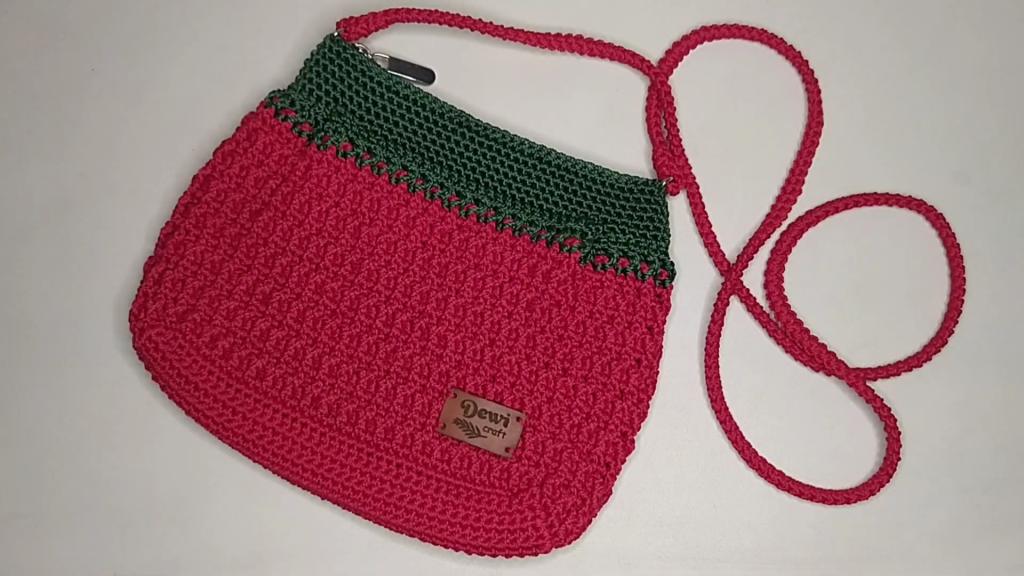
SC Border & D-Ring Integration:
- Ch 1, turn. Sc in each st around.
- Repeat for a total of 5 rounds of SC border.
Round 6 (D-Ring Integration):
- Continue the SC round until you reach the center of a narrow end (the side of the bag). Mark the center 4 stitches.
- D-Ring Attachment: Place the D-ring (1.5 cm) flat against the top edge. Work 4 SC over the metal ring, ensuring the ring is secured tightly.
- Continue SC across the top.
- Repeat the D-Ring Attachment process on the opposite narrow end of the bag.
- Sl st to join. Fasten off MC.
Video Tutorial:
✅ Part 4: Final Touches & Assembly
Your “Alpine Rib” Bag is now ready for finishing!
- Weave in Ends: Use your yarn needle to securely weave in all remaining yarn tails.
- Strap Attachment: Attach the finished strap ends (with snap hooks) to the integrated D-rings.
- Lining & Zipper (Recommended): The video suggests adding a custom fabric lining and zipper for a polished, functional finish and to prevent stretching.
Your finished “Alpine Rib” Shoulder Bag should measure:
- Length: 22 cm
- Height: 15 cm
- Weight: Approximately 160 grams.
Enjoy your durable and beautifully textured tote!


